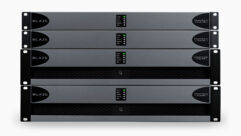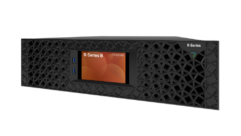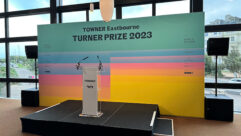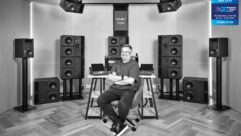
Mackie DLM-12S And DLM-8 Speakers Review
Aug 21, 2013 12:48 PM,
Reviewer: John McJunkin
Packing more SPL in a smaller box.

DLM-8
Portable compact powered speakers manufacturers compete with each other to develop appealing new features, improve quality, reduce weight, or otherwise do whatever it takes to entice prospective customers. One metric we use to distinguish one model from another is portability resulting from reduced size. If we could achieve ruler-flat reproduction at arena-level SPLs directionally dispersed exactly the way we want from a device the size of a carry-on suitcase, we’d pay nearly any price the manufacturer asked. Unfortunately, that kind of magic doesn’t exist quite yet, but getting more and more SPL from boxes that keep getting smaller is a goal toward which many manufacturers strive. The latest advancement in that domain from Mackie is the DLM series.
The series comprises three speakers, two speakers-on-a-stick based on 8in. and 12in. LF drivers, and the third is a subwoofer based on a 12in. LF driver. One of Mackie’s major goals was to deliver substantial SPL accurately from a system that is very portable. It’s not quite as small as the plastic PA-in-a-suitcase solutions offered by other manufacturers, but the size difference isn’t huge. In particular, a DLM system with a single DLM-12S subwoofer and two DLM-8 full-range speakers fits easily into a sub-compact car, provides very solid SPL performance, and is easily moved from car to venue on a single hand truck, along with a mixer, mics, and stands, and all necessary cabling. The DLM-12S is about 16.5in. wide, 18in. high, and 21in. deep, and weighs 48lbs.—not terribly difficult for one person to pick up by a recessed side handle, and very easy for two to carry abreast. The DLM-8 is the real marvel in terms of size: It’s roughly a 12in. cube, which is about the size of the box a basketball comes in. The DLM-12 is roughly 3in. larger in each dimension—not a huge enclosure for a 12in. LF driver. The real achievement, however, is the 8in. cabinet, which facilitates a very portable but potent system when coupled with the DLM-12S sub. I evaluated a system comprised of two DLM-8s and two DLM-12S subs.
In order to shrink the size of the DLM-8, Mackie was clever and deployed the LF and HF drivers in a coaxial orientation, allowing them to share a single ferrite magnet, and vertically aligning them. The LF driver’s diaphragm is formed of paper, while the HF driver employs a polyimide film diaphragm. The HF driver’s voice coil diameter is 13.4in., and the LF driver voice coil is 2in. The dispersion pattern is conical and 90 degrees wide, becoming more omnidirectional as frequency tapers downward. The physical alignment of the two drivers contributes to fidelity, but DSP is also employed to time-align the drivers and otherwise improve clarity. Mackie refers to this combination of physical alignment and DSP as TruSource technology. During my subjective listening assessment, this feature delivered a very distinct and obvious stereo image. The crossover point is 1.6kHz, and to my ear, was properly chosen for this LF/HF pairing; the transition sounds smooth. The overall frequency response is not extremely flat, but it works well in the applications Mackie suggests for these speakers. There is a substantial dip starting at about 450Hz up to just above 800Hz. It climbs back up modestly to about 1.2kHz, and remains mostly flat until about 2kHz, at which point there is another substantial dip, centered at about 3.2kHz, and climbing back up to a nominal level at about 10kHz, then tapering off to 20kHz and beyond. The speaker’s internal DSP offers six distinct EQ curves: PA speaker mode (full-range), DJ speaker mode (low and high bumps and “mild tuck” in the mids), soloist speaker mode (thump-reducing low roll-off with boosted mids and highs), monitor speaker mode (low roll-off and cut at 2kHz to increase gain-before-feedback), and EQ K and EQ Y, which mimic the response curves of popular competitors’ products. These curves are all generally on the contour described above, with the stated exceptions. Easy-to-use EQ presets in powered speaker-on-a-stick products have become very common.
The DLM-8 features two input channels to facilitate the mixing of a couple of sources. Channel one offers a combined XLR/1/4in. TRS input with a pushbutton to select the appropriate level range. Channel two has the same dual-purpose input, which can accept line or instrument level signals, along with a stereo pair of RCA inputs. A female XLR output facilitates loop-through for daisy-chaining. A pushbutton determines whether the loop output represents only the channel one input or both channels. The speaker’s DSP is controlled and displayed on an OLED, including input gain, preset EQ curves, three-band EQ, FX sends, alignment delay, six-filter automated feedback suppression, and preset storage/recall. The three-band EQ offers low shelving at 80Hz, mids centered at 2.5kHz, and high shelving at 12kHz. Fifteen decibels of boost or cut is available, in 3dB increments.

DLM-12S
I subjectively listened to a broad range of music styles. I listened at high and low levels, and with all the preset EQs engaged, applied the speaker’s internal effects to vocals and solo instruments—delays, reverbs, chorusing, and so forth. I also listened to the DLM-8 by itself, and also the DLM-8 pole-mounted atop the DLM-12S. First, I am impressed with the quantity of low-end that the small box can deliver by itself. It’s not sufficient for a gymnasium, but for guitar/vocalist coffeehouse-style applications, it holds its own. The PA system full-range setting sounded mid-rangey to my ear, but not in a bad, “honky” way (as systems with horn-loaded HF drivers are known to do). The DJ setting was more natural for pop and dance music. I would probably still punch up the highs a bit more than the preset curve, but not by much. The highs from the DLM-8 sound quite good, considering the price. These are not studio monitors, but the high end does not suffer from the brashness that a lot of inexpensive self-powered speakers do; it’s pretty smooth and doesn’t cut your head off. When the subwoofer is integrated into the mix, the full, broad spectrum is all there. The sub has crossover presets for both the DLM-8 and DLM-12, older Mackie speakers, and a variable mode that permits the user to set the crossover anywhere from 60Hz to 120Hz. The internal effects are nothing special, though better than expected in a self-powered speaker.
These speakers do fine with subtler, softer music, and spoken word, but they do particularly well with loud pop music. The clarity they exhibit with spoken word makes them very useful for small boardrooms up to moderately large banquet rooms, if they’re used with subwoofers. Obviously, the 12in. version of the full-range speaker will deliver even more SPL and more low-mids than its 8in. counterpart, opening up a wider range of applications for AV. The 8in. speaker alone would be more than sufficient for most boardroom-type presentations, even if music were included in a PowerPoint presentation. The price is reasonable, and the quality is there—these are very much worth a look.
PRODUCT SUMMARY
Pros: Very light and compact; solid SPL, clean and clear
Cons: A little mid-range
Applications: AV, light PA work, DJs, solo performer, monitors
Price: $1,240 (DLM-12S); $870 (DLM-8)
SPECIFICATIONS
DLM-8
Frequency Response (–10 dB): 65Hz – 20kHz
Max peak SPL (@ 1m calculated): 125dB
Crossover Point: 1.6kHz
Dispersion: 90º conical
Low Shelving: ±15dB @ 80Hz
Mid-Peaking: ±15dB @ 2.5kHz
High Shelving: ±15dB @ 12kHz
Rated THD: < 1%
Inputs:
Channel 1
Mic: 3.3kΩ balanced
Line: 20kΩ balanced; 10kΩ unbalanced
1/4″ TRS: 16kΩ balanced; 8kΩ unbalanced
Channel 2
XLR Line: 20kΩ balanced; 10kΩ unbalanced
1/4″ TRS [Hi-Z instrument]: 1MΩ unbalanced
RCA: 25kΩ unbalanced
DLM-12S
Frequency Response (–10 dB): 35Hz to user-selectable 90Hz – 135Hz
Max peak SPL (@ 1m calculated): 128dB
Crossover Point: User selectable 60Hz – 120Hz
Rated THD: < 1%
Inputs:
Balanced: Female XLR – 20 kΩ impedance
Unbalanced: Female XLR – 10 kΩ impedance
Outputs:
Full Range: Male XLR – balanced (parallel with input)
High Pass: Male XLR – balanced
Rated Power:
RMS: 1000W
Peak: 2000W
John McJunkin is the principal of Avalon Podcasting in Chandler, Ariz., and produces and co-hosts a top-rated morning radio talk show in Phoenix. He has consulted in the development of studios and installations and provides high-quality podcast and voice production services.










